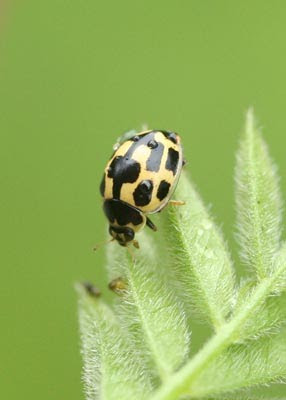Some days are just simply better than others.
Helophilus pendulus (to the lower left, below) is a very common hoverfly that has similar but scarcer relatives, so I always examine each specimen in the hope that it might be one of the scarcer ones.

Today I noticed that one of the many specimens was slightly different , especially in the amount of yellow on the abdomen. I managed one poor shot before it zoomed off to another area:

The photograph is just enough to identify it as
Helophilus hybridus, which requires black, boggy soil for its larvae. The habitat matches precisely, so that's one new species for today.
There is a stand of young Alder trees just opposite where we usually park the car, and this unusual mine caught my eye:

The mine is unusual in that the larva starts off at the midrib, makes one anticlockwise circuit between two veins and ends up back at the midrib. Then it appears to disappear. In fact, the larva is now tunnelling along the inside of the midrib and will appear a few veins closer to the petiole and will then cut an oval piece of leaf which it takes to the ground and will then roll up and pupate inside it. This extremely sophisticated beast is the micromoth
Heliozela resplendella, and is new species #2 for today.
New species #3 is the moth The Magpie. Notice the 'The'. For some unknown reason, about 60 of our moths have 'The' as the first part of their name. I suppose it happened as part of the original naming process and someone's list was kept differently and the names got stuck. Nice beast, anyway:

And the fourth and final new species for today is the Centre-barred Sallow, which is one of the few insects that is dependant on the Ash tree:

I would have been happy to call a halt on the page at this point, but I got a couple of other shots that are worth showing.
This
Eristalis nemorum hoverfly insisted on trying to mate with a worker
Bombus pascuorum bumblebee:

It made numerous slow approaches from above, each time forcing the bumblebee to move to another flowerhead. Eventually the bee gave up and flew away over the hedge, after which the hoverfly tried to approach a number of other bees and hoverflies.
Alder is host to a large number of insects and fungi, which is testament to its nutritional qualities as well as its obvious lack of protective toxins.
Taphrina alni is a rather scarce fungus which attacks the fruiting cones and forces them to produce these large, red tongue-like growths:

These growths (strictly-speaking, galls) are part Alder and part Taphrina, much in the manner of lichens, and their only purpose is to produce fungal spores.
The closer you look, the more complex it gets.
Four new species in one day.
 So I rather think the south-easterly wind that accompanied the current high-pressure weather system has brought in a mass migratory influx from mainland Europe.
So I rather think the south-easterly wind that accompanied the current high-pressure weather system has brought in a mass migratory influx from mainland Europe. I only ever see this on Ragwort. Its host caterpillar is unknown in Ireland, and I'm beginning to wonder if it's migratory, too. I need to sit and think if a migratory parasite makes sense.
I only ever see this on Ragwort. Its host caterpillar is unknown in Ireland, and I'm beginning to wonder if it's migratory, too. I need to sit and think if a migratory parasite makes sense.






















































